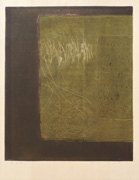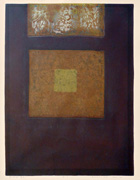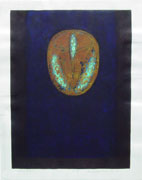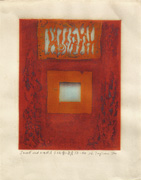Prints in Collection
Fantasy 夢想 C, 1966 IHL Cat. #2397 | Saint, 1970 IHL Cat. #188 | Small Red Wall A, 1972 IHL Cat. #634 |
Biographical Data
Biography
Tajima Hiroyuki 田嶋宏行 (1911-1997)1
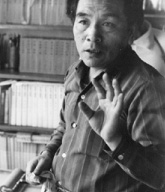 Sources: Guide to Modern Japanese Woodblock Prints: 1900-1975, Helen Merritt, University of Hawaii Press, 1992, p. 141; Modern Japanese Prints: 1912-1989, Lawrence Smith, British Museum Press, 1994, p. 35 and as footnoted.
Sources: Guide to Modern Japanese Woodblock Prints: 1900-1975, Helen Merritt, University of Hawaii Press, 1992, p. 141; Modern Japanese Prints: 1912-1989, Lawrence Smith, British Museum Press, 1994, p. 35 and as footnoted.
Hiroyuki Tajima was born in Tokyo in 1911. He studied art at Nihon University, graduating in 1932, and the Tokyo School of Arts where he graduated in 1934, having specialized in western style painting. He also studied fabric dyeing under Hirokawa Matsugoro (1889-1952) and woodblock printing with the sosaku hanga artist Nagase Yoshiro (1891-1978), a founding father of the Japan Print Association (Hanga Kyokai). In 1946, inspired by and attracted to the artistic ideals of Dada and Surrealism, he joined Bijutsu Bunka Kyokai, a group dedicated to exploring and reviving the abstract and surrealist painting ideals that had been suppressed during WWII.
"In the 1960s and 70s he developed his typical densely pigmented abstract style, which, however, was based on the ideals of East Asian calligraphy, traditional Japanese painting structure, and a sense of space derived partly from his Zen Buddhist beliefs. His abstract prints typically have complex surfaces achieved by building up the block with various materials such as crumpled paper. At this time he also made a living from producing more popular landscape prints under the name of Nagai Kiyoshi."2
In describing Tajima's work Francis Blakemore comments: "Every Tajima work seems to glow from behind, as though it incorporated a fluorescent light shielded by a mysteriously textured fabric. ... Tajima's technique consists of brushing intensely colored dyes over a dark-colored medium, imparting luminosity to the white areas while enriching the basic colors of the print. The textured areas fade off into dark planes, seeming to float on a cool liquid. Thus the fascinating, bubbly shapes are set off by simple, relaxing ground forms. In this end, this rare combination of intricacy and confident simplicity makes Tajima's work both exciting and reassuring."3
Tajima prints layers of color, creating the impression of a solid structure and of a luminous glow emanating from the surface of the print. His titles are allusive, often literary, but they are carefully chosen to guide the viewer’s imagination to the artist’s meaning.4
“The rich velvety colors and sensuous textures of Tajima’s prints are not ends in themselves but are purposely used to conjure up a mysterious and mystical space.”5
Tajima succeeded in developing a style that was truly original. He created abstract heavily pigmented creations rooted in traditional Japanese painting composition, Asian calligraphy, and an awareness of spatial integrity derived from his Zen Buddhist beliefs.

Hiroyuki Tajima was born in Tokyo in 1911. He studied art at Nihon University, graduating in 1932, and the Tokyo School of Arts where he graduated in 1934, having specialized in western style painting. He also studied fabric dyeing under Hirokawa Matsugoro (1889-1952) and woodblock printing with the sosaku hanga artist Nagase Yoshiro (1891-1978), a founding father of the Japan Print Association (Hanga Kyokai). In 1946, inspired by and attracted to the artistic ideals of Dada and Surrealism, he joined Bijutsu Bunka Kyokai, a group dedicated to exploring and reviving the abstract and surrealist painting ideals that had been suppressed during WWII.
"In the 1960s and 70s he developed his typical densely pigmented abstract style, which, however, was based on the ideals of East Asian calligraphy, traditional Japanese painting structure, and a sense of space derived partly from his Zen Buddhist beliefs. His abstract prints typically have complex surfaces achieved by building up the block with various materials such as crumpled paper. At this time he also made a living from producing more popular landscape prints under the name of Nagai Kiyoshi."2
In describing Tajima's work Francis Blakemore comments: "Every Tajima work seems to glow from behind, as though it incorporated a fluorescent light shielded by a mysteriously textured fabric. ... Tajima's technique consists of brushing intensely colored dyes over a dark-colored medium, imparting luminosity to the white areas while enriching the basic colors of the print. The textured areas fade off into dark planes, seeming to float on a cool liquid. Thus the fascinating, bubbly shapes are set off by simple, relaxing ground forms. In this end, this rare combination of intricacy and confident simplicity makes Tajima's work both exciting and reassuring."3
Tajima prints layers of color, creating the impression of a solid structure and of a luminous glow emanating from the surface of the print. His titles are allusive, often literary, but they are carefully chosen to guide the viewer’s imagination to the artist’s meaning.4
“The rich velvety colors and sensuous textures of Tajima’s prints are not ends in themselves but are purposely used to conjure up a mysterious and mystical space.”5
Tajima succeeded in developing a style that was truly original. He created abstract heavily pigmented creations rooted in traditional Japanese painting composition, Asian calligraphy, and an awareness of spatial integrity derived from his Zen Buddhist beliefs.
Museum Collections (Partial List)
Portland Art Museum, Portland, Oregon; Cleveland Museum of Art; Los Angeles County Museum of Art; Fine Arts Museums of San Francisco; Art Gallery of Greater Victoria; Art Gallery of New South Wales; Carnegie Museum of Art; The National Museum of Art, Osaka; British Museum [holds 89 works of artist, including a number of artist final proof prints (bon á tirer) donated by his wife Tajima Toshie.]1 While Merritt and Smith and several other sources give cite 1984 at the year of the artist's death, several Japanese blogs give a date of death of 1997 along with the union catalogue of Japanese national museums (http://search.artmuseums.go.jp/records.php?sakuhin=52436)
2 Modern Japanese Prints: 1912-1989, Lawrence Smith, British Museum Press, 1994, p. 35
3 Who's Who in Modern Japanese Prints, Frances Blakemore, Weatherhill, 1975, p. 192.
4 Cleveland Museum of Art website (original link now inactive)
5 44 Modern Japanese Print Artists, Gaston Petit, Kodansha International Ltd., 1973, p. 135.
last revision:
8/1/2020
